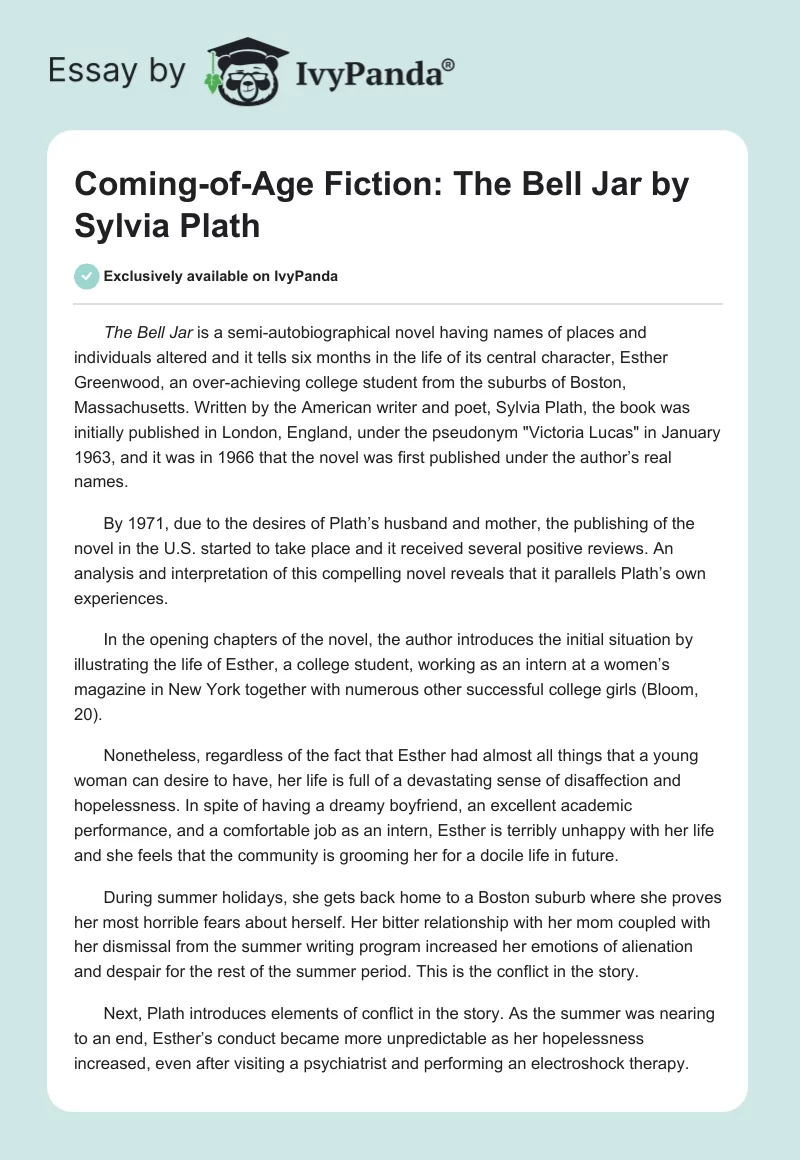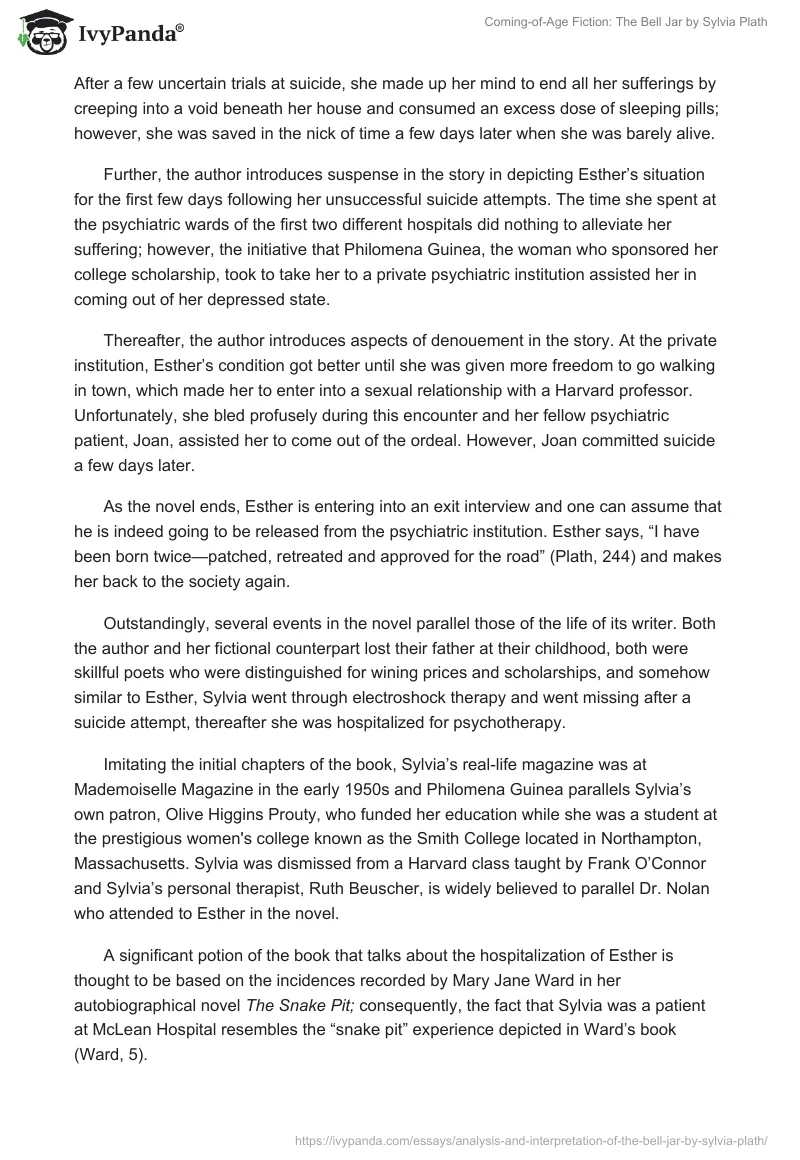The Bell Jar is a semi-autobiographical novel having names of places and individuals altered and it tells six months in the life of its central character, Esther Greenwood, an over-achieving college student from the suburbs of Boston, Massachusetts. Written by the American writer and poet, Sylvia Plath, the book was initially published in London, England, under the pseudonym “Victoria Lucas” in January 1963, and it was in 1966 that the novel was first published under the author’s real names.
By 1971, due to the desires of Plath’s husband and mother, the publishing of the novel in the U.S. started to take place and it received several positive reviews. An analysis and interpretation of this compelling novel reveals that it parallels Plath’s own experiences.
In the opening chapters of the novel, the author introduces the initial situation by illustrating the life of Esther, a college student, working as an intern at a women’s magazine in New York together with numerous other successful college girls (Bloom, 20).
Nonetheless, regardless of the fact that Esther had almost all things that a young woman can desire to have, her life is full of a devastating sense of disaffection and hopelessness. In spite of having a dreamy boyfriend, an excellent academic performance, and a comfortable job as an intern, Esther is terribly unhappy with her life and she feels that the community is grooming her for a docile life in future.
During summer holidays, she gets back home to a Boston suburb where she proves her most horrible fears about herself. Her bitter relationship with her mom coupled with her dismissal from the summer writing program increased her emotions of alienation and despair for the rest of the summer period. This is the conflict in the story.
Next, Plath introduces elements of conflict in the story. As the summer was nearing to an end, Esther’s conduct became more unpredictable as her hopelessness increased, even after visiting a psychiatrist and performing an electroshock therapy. After a few uncertain trials at suicide, she made up her mind to end all her sufferings by creeping into a void beneath her house and consumed an excess dose of sleeping pills; however, she was saved in the nick of time a few days later when she was barely alive.
Further, the author introduces suspense in the story in depicting Esther’s situation for the first few days following her unsuccessful suicide attempts. The time she spent at the psychiatric wards of the first two different hospitals did nothing to alleviate her suffering; however, the initiative that Philomena Guinea, the woman who sponsored her college scholarship, took to take her to a private psychiatric institution assisted her in coming out of her depressed state.
Thereafter, the author introduces aspects of denouement in the story. At the private institution, Esther’s condition got better until she was given more freedom to go walking in town, which made her to enter into a sexual relationship with a Harvard professor. Unfortunately, she bled profusely during this encounter and her fellow psychiatric patient, Joan, assisted her to come out of the ordeal. However, Joan committed suicide a few days later.
As the novel ends, Esther is entering into an exit interview and one can assume that he is indeed going to be released from the psychiatric institution. Esther says, “I have been born twice—patched, retreated and approved for the road” (Plath, 244) and makes her back to the society again.
Outstandingly, several events in the novel parallel those of the life of its writer. Both the author and her fictional counterpart lost their father at their childhood, both were skillful poets who were distinguished for wining prices and scholarships, and somehow similar to Esther, Sylvia went through electroshock therapy and went missing after a suicide attempt, thereafter she was hospitalized for psychotherapy.
Imitating the initial chapters of the book, Sylvia’s real-life magazine was at Mademoiselle Magazine in the early 1950s and Philomena Guinea parallels Sylvia’s own patron, Olive Higgins Prouty, who funded her education while she was a student at the prestigious women’s college known as the Smith College located in Northampton, Massachusetts. Sylvia was dismissed from a Harvard class taught by Frank O’Connor and Sylvia’s personal therapist, Ruth Beuscher, is widely believed to parallel Dr. Nolan who attended to Esther in the novel.
A significant potion of the book that talks about the hospitalization of Esther is thought to be based on the incidences recorded by Mary Jane Ward in her autobiographical novel The Snake Pit; consequently, the fact that Sylvia was a patient at McLean Hospital resembles the “snake pit” experience depicted in Ward’s book (Ward, 5).
It is important to note that Sylvia Intentionally based the depiction of Esther being in hospital on the practices and techniques described Ward’s novel. When the novel was initially published under its pseudonym, Sylvia was dissatisfied by the assessments that passed judgment on the book as a feminist corresponding item to the works of the American author, Jerome David Salinger.
The assessments were lukewarm, since British reviewers pointed that it was an analysis of American society and considered the title character to be a desperate individual, and, sadly, less than one month following the initial publication of the novel, Sylvia committed suicide through asphyxiation.
The major theme of the novel is a feminist one. Its main character goes through various difficulties under the restricted responsibilities available for the women of her time and the inferiority of women to men; thus, the story is a protest at the expectations that women are obliged to comply with so as to be regarded normal and victorious in the male-dominated society. One of the minor themes of the book is its portrayal of anxiety about death. The protagonist’s suicidal imaginations as well as imaginations of death pervade the book.
She is so incapacitated with anxiety that most of the time she does not respond to the things taking place around her and she feels often in the “hell” of her own mind. For example, this quotation, “…wherever I sat-on the deck of a ship or a street café in Paris or Bangkok I would be sitting under the same glass bell jar stewing, in my own sour air”(Plath, 185), introduces the symbol of the bell jar in the novel.
This illustrates that Esther’s suicidal imaginations are derived from a sense of suffocating isolation because of the large gap that exists between the expectation of the community about her and her own feelings and experiences, and, as such, she retreats more within herself as the bell jar is covered tightly over her.
And, in the last chapter, Esther’s supposed cure is depicted: “How did I know that someday—at college, in Europe, somewhere, anywhere—the bell jar, with its stifling distortions, wouldn’t descend again?” (Plath, 241).
A poem that Sylvia wrote in the month of her death named “Balloon” also illustrates this theme of anxiety of death. In the poem, she attempts to write down her thoughts about life, centering on the Christmas holiday she had just enjoyed with her family members.
Moreover, she also centers on a baby boy squeaking a balloon; however, in the end, the balloon is burst, leaving only a slice of red in the baby’s fist: “Then sits Back, fat jug contemplating a world clear as water. A red Shred in his little fist” (Plath, last paragraph). Thus, the “Balloon” early images are incorporeal, and then the culmination approaches, without anything.
In conclusion, the novel is in the genre of coming-of-age fiction because of the way it marked out the path of Esther, the protagonist in the story, as she moved in a crucial period in her life from an inexperienced teenager to an experienced young woman. The story is told in the narrator point-of-view; that is, the events are filtered through the novel’s protagonist, which forces the readers to follow what happens inside her head.
However, as much as this narrative style gives the readers a first hand information of what is happening, it becomes difficult to get an objective view of Esther or a more detailed analysis of the other characters in the novel. Narrated from the protagonist’s point-of-view, the novel’s tone is cynical, tormented, and humorous in its portrayal of the events that take place.
Works Cited
Bloom, Harold. Sylvia Plath’s The bell jar. New York, NY : Bloom’s Literary Criticism, 2009. Print.
Plath, Sylvia. “Balloons.” Poemhunter.com. Poem Hunter. 1963. Web.
Plath, Sylvia. The bell jar. New York: Harper Perennial, 2006. Print.
Ward, Mary. The snake pit. Cutchogue, N.Y.: Buccaneer Books, 1983. Print.

 4.33
4.33
